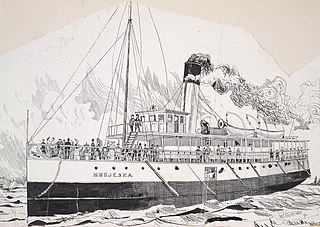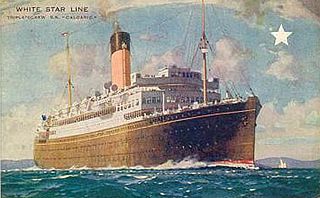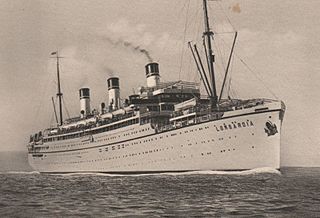
Stella was a passenger ferry in service with the London and South Western Railway (LSWR). She was built in Glasgow in 1890, and wrecked in 1899 off the Casquets during a crossing from Southampton to Guernsey.

SS Minnedosa was one of a pair of transatlantic steam ocean liners that were built in the United Kingdom, launched in 1917 and operated by Canadian Pacific until 1935. Her sister ship was Melita.

Komagata Maru was a cargo steamship that was built in Scotland in 1890, was in German ownership until 1913, and then had a succession of Japanese owners until she was wrecked in 1926. She was launched as Stubbenhuk, renamed Sicilia in 1894, Komagata Maru in 1913 and Heian Maru in 1924.

SS Manitoulin was a Great Lakes passenger steamship. She was built in 1889 as Modjeska, and renamed Manitoulin in 1927 after a major refit. She was laid up in 1949 and scrapped in 1953.

SS Polar Chief was a merchant steamship that was built in England in 1897 and scrapped in Scotland in 1952. In her 55-year career she had previously been called Montcalm, RFA Crenella, Crenella, Rey Alfonso, Anglo-Norse and Empire Chief. Early in the First World War she spent eight months pretending to be the battleship HMS Audacious.

Wickenburgh was a cargo liner that was built in 1938 as Adler by Lübecker Maschinenbau Gesellschaft, Lübeck for German owners. Requisitioned by the Kriegsmarine in 1940, she was seized by the Allies in Vordingborg, Denmark in May 1945, passed to the Ministry of War Transport (MoWT) and renamed Empire Coningsby. In 1946, she was transferred to the Dutch Government and renamed Margeca. In 1947 she was sold into merchant service and renamed Wickenburgh. In 1953 her compound steam engine and low-pressure steam turbine were replaced with a diesel engine, with a reduction in gross register tonnage from 1,494 to 1,420. She was sold to Greek owners in 1963 and renamed Nissos Thassos. In 1970 she was sold to Panamanian owners and renamed Savilco. She was scrapped in 1984.
Ramón Alonso R. was a merchant steamship that was built in Scotland in 1898 and scrapped in Spain in 1959. Her original name was Montclair. She was renamed José Gallart in 1901, Balmes in 1911 and Ramón Alonso R. in 1929. Her first owner was the British Elder Dempster Lines, but she spent most of her career with a succession of Spanish owners. She was built as a transatlantic ocean liner with some cargo capacity, but in 1927 she was refitted as a cargo ship. In 1913, when she was called Balmes, the ship survived a serious cargo fire in mid-Atlantic.

SS Waroonga was a steel-hulled passenger and cargo steamship that was launched in Scotland in 1882, renamed Bansei Maru in 1913 and scrapped in Japan in 1926. Her career included periods in British, Australian and Japanese ownership.

SS Calgaric was a steam ocean liner that was completed in 1917, assumes service in 1918 and scrapped in 1934. She was built for the Pacific SN Co Line as Orca. In 1923 she was transferred to the Royal Mail Line. In 1927 she was transferred to White Star Line and renamed Calgaric.

SS Themistocles was a UK steam ocean liner and refrigerated cargo ship. She was launched in 1910 in Ireland and scrapped in 1947 in Scotland. She was built for Aberdeen Line, White Star Line managed her for a few years, and she spent the latter part of her career with Shaw, Savill & Albion Line.
SS Hertford was a refrigerated cargo steamship that was launched in Germany in 1917, seized by the United Kingdom in 1920 as World War I reparations, and sunk by a U-boat in 1942 with the loss of four members of her crew.
TSS City of Belfast was a passenger steamship that was built in England in 1893, renamed Nicolaos Togias in 1925, renamed Kephallinia in 1933 and sank in 1941. She was owned and registered in Britain until 1925, when she passed to Greek owners.

SS City of Leeds was a British North Sea passenger and cargo steamship that was built in Yorkshire in 1903 and scrapped in Northumberland 1937. In the First World War the Imperial German Navy captured her and used her as a depot ship.

SS Frederica was a passenger ferry that was built in Scotland in 1890 for the London and South Western Railway. In 1912 she was sold to Ottoman owners who renamed her Nilufer. In 1914 the Ottoman Navy used her as a minelayer. A mine sank her in November 1914.

SS Westernland was a transatlantic ocean liner that was launched as Regina in Scotland in 1917, renamed Westernland in 1929 and was scrapped in 1947. She began her career as a troop ship repatriating US troops after the Armistice of 11 November 1918. In the Second World War, Westernland served as a troop ship, repair ship and destroyer depot ship.
Rahmi Kaptan was a ship that was built in 1873 as Honfleur by Aitken & Mansel, Glasgow for the London and South Western Railway. She was sold to Greece in 1911 and renamed Chrysallis then Chrysalis. She was sold to the French Navy in 1917 and served as the patrol vessel Fauvette, later Fauvette I. In 1924, she was sold to Turkey and renamed Ihsanie. She operated for a number of Turkish owners under the names Aidin, Aydin, Cihat, Demirhisar and Rahmi Kaptan, serving until c.2005.

SS Grampian was a transatlantic ocean liner that was built in Scotland in 1907 and scrapped in the Netherlands in 1925. She was operated originally by Allan Line, and later by Canadian Pacific Steamships. In the First World War she remained in commercial service but carried Canadian troops. In 1919 she survived a collision with an iceberg. In 1921 she was gutted by fire while being refitted. The refit was abandoned, and in 1925–26 she was scrapped.
Olsztyn was a Hansa A Type cargo ship which was built as Imkenturm in 1944 by Werf de Noord, Alblasserdam, Netherlands for DDG Hansa, Bremen, Germany. She was seized as a prize of war in 1945, passing to the Ministry of War Transport and renamed Empire Gantry. She was allocated to the Soviet Union in 1946 and was renamed Feodosia. Sold to Poland in 1947, she was renamed Olsztyn. She served until 1972, when she was scrapped.
SS Melita was one of a pair of transatlantic steam ocean liners that were built in the United Kingdom, launched in 1917 and operated by Canadian Pacific until 1935. Her sister ship was Minnedosa.

SS Lombardia was one of a pair of transatlantic steam ocean liners that were launched in 1914 in Germany for the Hamburg America Line (HAPAG), sold to a Dutch shipping line in 1916, and seized by the United States as World War I reparations in 1922. United American Lines (UAL) operated her until 1926, when HAPAG bought her back.














